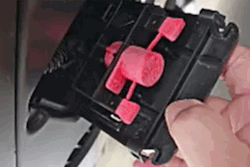12 V terminal We found an opportunity to look at the 12 V terminal in a Polestar 3 and, aside from having to lie on the floor or ground, its a relatively simple find and simple to use. So, the trick, if you will, is to lie beneath the front bumper on the left side. …
Category: Articles & Commentaries
Discussions on topics of interest to drivers concerning things they may not understand about their vehicles as well as articles on the future of the auto industry.
Permanent link to this article: https://dashboardsymbols.com/2025/09/new-engine-idea-from-subaru-for-future-evs/
Permanent link to this article: https://dashboardsymbols.com/2025/09/polestar-12-v-terminal-revealed/
2026 Polestar symbols review complete
Polestar symbols Since we’ve been spending so much time on Polestar models of late, we opted to review the companies dashboard symbols for 2026. The result is the addition of only eight images to the Polestar symbols page. The page now holds 85 indicators and symbols, which is actually small compared to others but large …
Permanent link to this article: https://dashboardsymbols.com/2025/09/2026-polestar-symbols-review-complete/
Polestar interior emergency release is an intuitive breeze to use
Interior emergency release We had an opportunity to spend some time with a Polestar 3 and got some video of the interior door handle. The interior emergency release is easier to use than the company, or companies, describe. As with too many features described in Polestar and Volvo owner’s manuals, there are no images available …
Permanent link to this article: https://dashboardsymbols.com/2025/09/polestar-interior-emergency-release-is-an-intuitive-breeze-to-use/
Parker’s Mobile Mechanics (@ParkersMobile, #ParkersMobile) earns, and gets, this shout out
Parker’s Mobile Mechanics I ran across a video short on YouTube that I first thought was someone being staked but turned out to be from Parker’s Mobile Mechanics. And they actually did follow the woman. I’ll link the video below. It turns out that Parker’s Mobile Mechanics offers completely free mechanical service to folks that …
Permanent link to this article: https://dashboardsymbols.com/2025/09/parkers-mobile-mechanics-earns-and-gets-this-shout-out/
Volvo, Polestar add needless complexity to open door indicator
Open door While we continue to gather what we need for a Polestar and Volvo jump start video, we ran across the image below right. It is a somewhat familiar open door warning with added coloring, or lack thereof. Some late (~2025 and newer) models have rather pointlessly added seat coloring, or rather de-coloring, to …
Permanent link to this article: https://dashboardsymbols.com/2025/09/volvo-polestar-add-needless-complexity-to-open-door-indicator/
Lucid gets the Get Out page nod too
Get Out Just yesterday we updated our Get Out page with entries from Volvo and Polestar. Which prompted a very first look into what Lucid was up to with their locks and latches. Sure enough, they followed the trend essentially begun by Tesla with electronic locks and latches and flush handles that essentially require a …
Permanent link to this article: https://dashboardsymbols.com/2025/09/lucid-gets-the-get-out-page-nod-too/



New engine idea from Subaru for future EVs?
Future EVs? So I saw this headline at gearpatrol.com: “Subaru Just Patented a Wild New Engine Idea for Its Future EVs.” So, we had to read it, and it turns out to essentially pertain to hybrid electric vehicles not pure EVs! The engine is a gasoline engine used to recharge the battery like the Chevy …
Continue reading